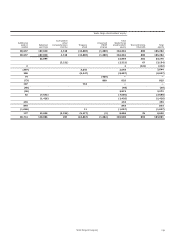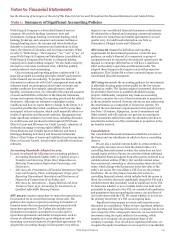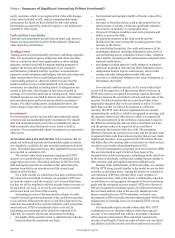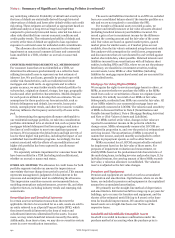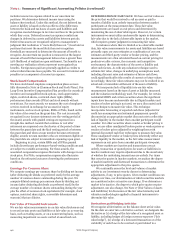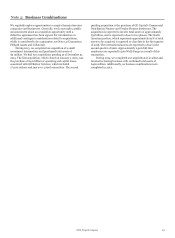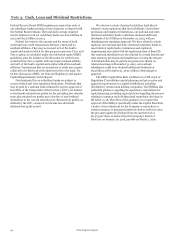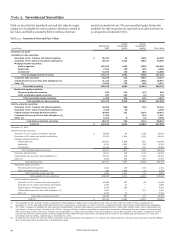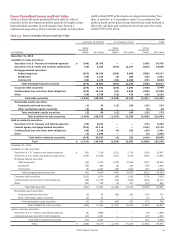Wells Fargo 2015 Annual Report Download - page 151
Download and view the complete annual report
Please find page 151 of the 2015 Wells Fargo annual report below. You can navigate through the pages in the report by either clicking on the pages listed below, or by using the keyword search tool below to find specific information within the annual report.recognized asset or liability (“cash flow hedge”), or (3) held for
trading, customer accommodation or asset/liability risk
management purposes, including economic hedges not
qualifying for hedge accounting. For a fair value hedge, we
record changes in the fair value of the derivative and, to the
extent that it is effective, changes in the fair value of the hedged
asset or liability attributable to the hedged risk, in current period
earnings in the same financial statement category as the hedged
item. For a cash flow hedge, we record changes in the fair value
of the derivative to the extent that it is effective in OCI, with any
ineffectiveness recorded in current period earnings. We
subsequently reclassify these changes in fair value to net income
in the same period(s) that the hedged transaction affects net
income in the same financial statement category as the hedged
item. For derivatives not designated as a fair value or cash flow
hedge, we report changes in the fair values in current period
noninterest income.
For fair value and cash flow hedges qualifying for hedge
accounting, we formally document at inception the relationship
between hedging instruments and hedged items, our risk
management objective, strategy and our evaluation of
effectiveness for our hedge transactions. This process includes
linking all derivatives designated as fair value or cash flow
hedges to specific assets and liabilities on the balance sheet or to
specific forecasted transactions. Periodically, as required, we
also formally assess whether the derivative we designated in
each hedging relationship is expected to be and has been highly
effective in offsetting changes in fair values or cash flows of the
hedged item using the regression analysis method.
We discontinue hedge accounting prospectively when (1) a
derivative is no longer highly effective in offsetting changes in
the fair value or cash flows of a hedged item, (2) a derivative
expires or is sold, terminated or exercised, (3) we elect to
discontinue the designation of a derivative as a hedge, or (4) in a
cash flow hedge, a derivative is de-designated because it is not
probable that a forecasted transaction will occur.
When we discontinue fair value hedge accounting, we no
longer adjust the previously hedged asset or liability for changes
in fair value, and cumulative adjustments to the hedged item are
accounted for in the same manner as other components of the
carrying amount of the asset or liability. If the derivative
continues to be held after fair value hedge accounting ceases, we
carry the derivative on the balance sheet at its fair value with
changes in fair value included in earnings.
When we discontinue cash flow hedge accounting and it is
probable that the forecasted transaction will occur, the
accumulated amount reported in OCI at the de-designation date
continues to be reported in OCI until the forecasted transaction
affects earnings. If cash flow hedge accounting is discontinued
and it is probable the forecasted transaction will not occur, the
accumulated amount reported in OCI at the de-designation date
is immediately recognized in earnings. If the derivative
continues to be held after cash flow hedge accounting ceases, we
carry the derivative on the balance sheet at its fair value with
future changes in fair value included in earnings.
We may purchase or originate financial instruments that
contain an embedded derivative. At inception of the financial
instrument, we assess (1) if the economic characteristics of the
embedded derivative are not clearly and closely related to the
economic characteristics of the financial instrument (host
contract), (2) if the financial instrument that embodies both the
embedded derivative and the host contract is not measured at
fair value with changes in fair value reported in earnings, and (3)
if a separate instrument with the same terms as the embedded
instrument would meet the definition of a derivative. If the
embedded derivative meets all of these conditions, we separate it
from the host contract by recording the bifurcated derivative at
fair value and the remaining host contract at the difference
between the basis of the hybrid instrument and the fair value of
the bifurcated derivative. The bifurcated derivative is carried at
fair value with changes recorded in current period earnings.
By using derivatives, we are exposed to counterparty credit
risk, which is the risk that counterparties to the derivative
contracts do not perform as expected. If a counterparty fails to
perform, our counterparty credit risk is equal to the amount
reported as a derivative asset on our balance sheet. The amounts
reported as a derivative asset are derivative contracts in a gain
position, and to the extent subject to legally enforceable master
netting arrangements, net of derivatives in a loss position with
the same counterparty and cash collateral received. We minimize
counterparty credit risk through credit approvals, limits,
monitoring procedures, executing master netting arrangements
and obtaining collateral, where appropriate. To the extent
derivatives subject to master netting arrangements meet the
applicable requirements, including determining the legal
enforceability of the arrangement, it is our policy to present
derivative balances and related cash collateral amounts net on
the balance sheet. Counterparty credit risk related to derivatives
is considered in determining fair value and our assessment of
hedge effectiveness.
Private Share Repurchases
During 2015 and 2014, we repurchased approximately 64 million
shares and 66 million shares of our common stock, respectively,
under private forward repurchase contracts. We enter into these
transactions with unrelated third parties to complement our
open-market common stock repurchase strategies, to allow us to
manage our share repurchases in a manner consistent with our
capital plans, currently submitted under the 2015
Comprehensive Capital Analysis and Review (CCAR), and to
provide an economic benefit to the Company.
Our payments to the counterparties for these private share
repurchase contracts are recorded in permanent equity in the
quarter paid and are not subject to re-measurement. The
classification of the up-front payments as permanent equity
assures that we have appropriate repurchase timing consistent
with our 2015 capital plan, which contemplated a fixed dollar
amount available per quarter for share repurchases pursuant to
Federal Reserve Board (FRB) supervisory guidance. In return,
the counterparty agrees to deliver a variable number of shares
based on a per share discount to the volume-weighted average
stock price over the contract period. There are no scenarios
where the contracts would not either physically settle in shares
or allow us to choose the settlement method.
In fourth quarter 2015, we entered into a private forward
repurchase contract and paid $500 million to an unrelated third
party. This contract settled in first quarter 2016 for 9.2 million
shares of common stock. At December 31, 2014, we had a
$750 million private forward repurchase contract outstanding
that settled in first quarter 2015 for 14.3 million shares of
common stock. Our total number of outstanding shares of
common stock is not reduced until settlement of the private
share repurchase contract.
Wells Fargo & Company
149


